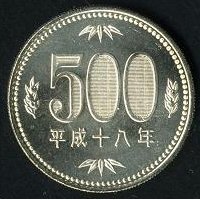500 yen coin
| Japan | |
| Value | 500 Japanese yen |
|---|---|
| Mass | 7.00 g |
| Diameter | 26.5 mm |
| Thickness | 2 mm |
| Edge | Helically reeded edge |
| Composition | 72% Cu 20% Zn 8% Ni |
| Years of minting | 1982 - Present |
| Catalog number | - |
| Obverse | |
 |
|
| Design | Paulownia |
| Designer | - |
| Design date | 2000 |
| Reverse | |
 |
|
| Design | Bamboo, Citrus tachibana |
| Designer | - |
| Design date | 2000 |
The 500 yen coin (五百円硬貨 Gohyaku-en kōka?) is the largest coin denomination of the Japanese yen.
The 500 yen coin was first minted in 1982 to replace the 500 yen note, which continued to be used alongside it until April 1, 1994. Soon, it became the victim of counterfeiting, as neighboring South Korea introduced its 500 won coin and could be easily modified to the exact weight of the ¥500 coin. As the ₩500 coin was roughly one-tenth the value of the ¥500 coin, these modified coins could be used at vending machines to produce a profit. The ₩500 coin was slightly heavier than the ¥500 coin, whilst having exactly the same diameter and metal alloy, meaning that counterfeiters would drill small holes on the surface of the coin to reduce its weight, and fool vending machines which relied on weight to identify coins.
A new design was minted in 2000. Zinc was added to give it a distinctive electrical conductivity, the weight was reduced 0.2 grams, and a latent image was added to the zeros on the obverse. When viewed at an angle, "500円" is printed vertically in each zero. When viewed at a different angle, a bar can be seen running down the inside of each zero. This bar is narrower than the "500円" text.Microprinting reading "Nippon" is found on both the obverse and reverse of the coin. Within the span of a few years, vending machines were replaced by new models by manufacturers which verified coins based on electrical conductivity; while the old style 500 yen coins are still in circulation, many vending machines no longer accept them.
Despite these anti-counterfeiting measures, the coin is still the target of counterfeiters in Japan.
Throughout the coin's history, the Japan Mint has issued 500 yen coins commemorating the various subjects of Japan's history.
...
Wikipedia
